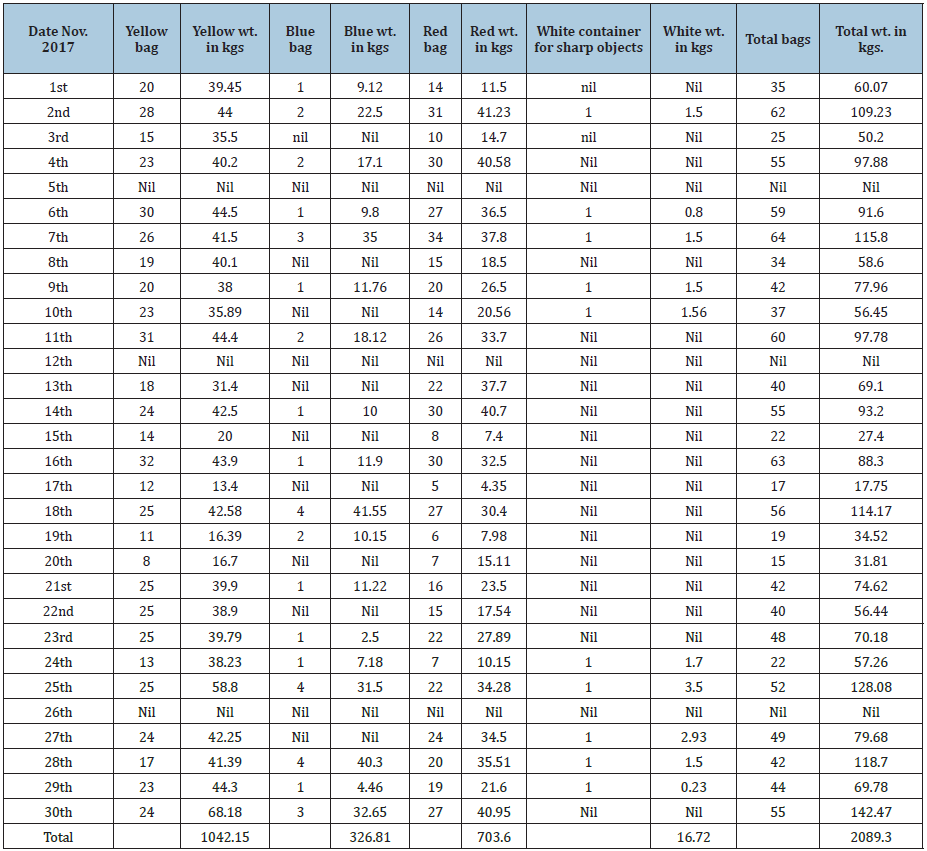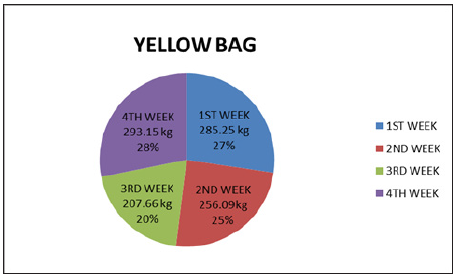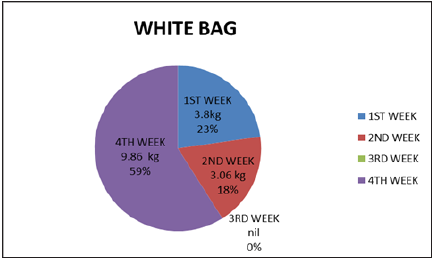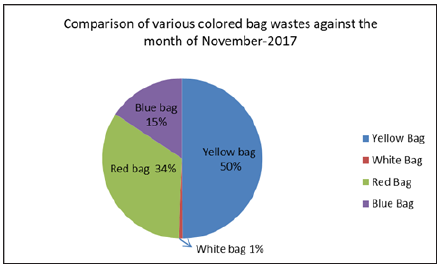Biomedical Waste Management in A Multispecialty Hospital by Vivek Kumar Garg in COJ Reviews & Research_Journal of Pharmaceutical Sciences Review and Research
Abstract
Any waste which is generated during the diagnosis, treatment, or immunization of human beings or animals or in research activities pertaining thereto or in the production or testing of biologicals, is called biomedical waste. The current study is based on BMW in multispecialty hospital at civil hospital, Barnala, India. The material used in the papers regarding BMW management is the Questionnaire, prepared with different topics. Our objective in the study was to evaluate the good points as well as the lacunas in the protocols adopted in the hospital waste management and its disposal, in the multispecialty civil hospital. In the present study, a list of departments of civil hospital, Barnala was made. There are following departments like General Medicine, General Surgery, Gynecology, Pediatrics, Ophthalmology, ENT, Dental, Skin, Orthopedics, Blood bank, OT, Wards, Indoor etc. The results obtained showed lack of awareness of bio medical waste management and its handling even in qualified medical staff. The reason being its complex is system and rules that has not become part of daily curriculum till now. We have studied one month regular protocol followed for bio medical waste collection by the hospital staff. During the study, we have observed that the hospital is properly managing their biomedical waste. Regularly, the hospital segregates the waste according to the specified categories and color coding. Regarding the capabilities and risks of biomedical waste treatment alternatives, it must be emphasized that the only treatment technologies that are usually used to treat pathological waste are the incineration and mechanical/ chemical disinfection systems.
Keywords: Biomedical waste; Healthcare; Multispecialty; Hospitals
Introduction
Any waste which is generated during the diagnosis, treatment, or immunization of human beings or animals or in research activities pertaining thereto or in the production or testing of biologicals, is called biomedical waste [1]. Medical care is indispensable for our life. But the waste generated during medical care needs attention. The nosocomial (hospital acquired) infections are the result of hospital waste. The hazardous and toxic parts of waste from healthcare establishments comprising infectious, biomedical and radioactive material as well as sharps needles, constitute a grave risk. The rag pickers and waste workers are often worst affected. Diseases like cholera, typhoid, plague, tuberculosis, hepatitis, AIDS, Diphtheria, Malaria, etc. pose grave public health risks [2-4]. With a judicious planning and management, the risk of spread of disease can be considerably reduced. The rules framed by the Ministry of Environment and Forests (MoEF), Govt. of India, known as Bio Medical Waste Management and Handling Rules, 1998, provides uniform guidelines and code of practice for the whole nation [5,6]. In Schedule I of the Bio Medical Waste Management rules 1998 (Annexure II), waste has been categorized into 10 points [2,4,7]. There are total 6 schedules in BMW management.
Schedule I: (Table 1)
Table 1: Schedule I.

Schedule II: (Table 1)
Table 2: Schedule II: Colour coding charts and type of container for disposal of BMW is as follows.

Schedule III: Labels for BMW containers/Bags
Schedule IV: Label for transport of BMW containers/Bags
Schedule V: Standards for treatment and disposal of BMW standards for incinerators.
Schedule VI: Schedule for waste treatment facilities like Incinerator/Autoclave/Microwave system.
Materials and Methods
The current study is based on BMW in multispecialty hospital at civil hospital, Barnala, India. The material used in the papers regarding BMW management is the Questionnaire, prepared with different topics.
Methods- The questionnaire was prepared by keeping following points in mind.
- Awareness of the importance of BMW management
- What is BMW
- Types of BMW
- BMW management at different levels- means at small clinics to big hospitals to medical and dental colleges.
- Classification of BMW
- Isolation of BMW
- Packaging of BMW and its disposal practices
Selection criteria to distribute questionnaire- The first step is preparation of questionnaire, study sample selected, organized and finalized. The second stage included distribution of questionnaire, analyzing the collected data and determining the response. Selection criteria for the persons are determined- The person must be part of healthcare, graduate or undergraduate, knowledge of English language, medical or paramedical staff, male or female, small clinics, primary health centers, polyclinics, multispecialty hospitals, government civil hospitals.
Aims and Objectives
To evaluate the steps taken in the management of hospital generated bio medical waste. Our objective in the study was to evaluate the good points as well as the lacunas in the protocols adopted in the hospital waste management and its disposal, in the multispecialty civil hospital. In the present study, a list of departments of civil hospital, Barnala was made. There are following departments like General Medicine, General Surgery, Gynecology, Pediatrics, Ophthalmology, ENT, Dental, Skin, Orthopedics, Blood bank, OT, Wards, Indoor etc. It took one month to record bio medical waste generation of all departments separately for Red, Yellow, Blue and White containers/bags. Then we added the waste for Red of all departments into one head, Yellow of all departments into one head, Blue of all departments into one head and White of all departments into one head. This all was infected waste. The non-infected waste e.g. expired medicines were put in Black colored container. But we did not include non-infected waste in our study. Since, our topic is focused on the protocols, that means we have to keep eye on the proper segregation of the waste before putting into their respective color-coded containers in their respective departments.
Result
Red Bag- Solid waste, POP casts, infected cotton & dressing, infected bandages, items containing blood & body fluid like extracted teeth, cysts, granulomas
Yellow Bag- Anatomical waste Microbiology & Biotechnology waste. Wastes from lab cultures or specimen of microbes live or attenuated vaccines, human and animal cell cultures, waste from production of biological, toxins, dishes & devices.
Blue Bag- Disposable plastic glasses, Plastic Tubings, IV sets, syringes, Gloves, Solid waste other than sharp needles/blades.
White Container- Sharp needles/objects that may cause cuts, Needles, Blades, expired injections, cut glasses.
Black Container- All above mentioned color bags contain Infected Waste. But Black color bag contains Non-Infected waste. e.g. cytotoxic drugs, chemical waste, expired drugs tablets & capsule form.
We studied one-month 1st November 2017 to 30th November 2017, BMW collection and disposal and its Protocols followed in the Civil Hospital, Barnala (Table 3) (Figure 1-5).
Table 3: BMW November 2017, civil hospitaal, Barnala.

Figure 1: Comparison of average yellow bag waste week wise for the month of November 2017.

Figure 2: Comparison of average red bag waste week wise for the month of November 2017.

Figure 3: Comparison of average blue bag waste week wise for the month of November 2017.

Figure 4: Comparison of average white bag waste week wise for the month of November 2017.

Figure 5: BMW report of November 2017 civil hospital, Barnala.

BMW report of November 2017 civil hospital, Barnala
Yellow container - 1042.15kg, Blue container -- 323.57kg
Red container – 696kg, White bag - 13.12kg, Total waste --2066.64kg
Total deliveries in the Gynae Deptt. --495 in number
Human Anatomical waste from Gynae deliveries inkgs - approx 0.5kg per delivery.
Total deliveries=495
So Total Human anatomical waste from gynae depth was 495 x 0.5=247.500kg
Out of 1034.95kg of waste of yellow container, 1042.15-247.500=794.65kg
Means Yellow container contains 247.500kg Human anatomic waste and 794.65kg is other solid waste.
Liquid waste generated after washing instruments and lab containers, test tubes was 300 liters in one-month November 2017.
Discussion of Diagrams
Yellow bag diagram with human anatomical waste with placentas shows
285.25kg and 27% 1st week of November 2017
256.09kg and 25% 2nd week of November 2017
207.66kg and 20% 3rd week of November 2017
293.15kg and 28% 4th week of November 2017
Blue bag diagram with infected plastics, syringes, gloves, plastic tubing’s shows
93.52kg and 29% 1st week of November 2017
51.78kg and 16% 2nd week of November 2017
65.42kg and 20% 3rd week of November 2017
116.09kg and 35% 4th week of November 2017
Red bag diagram with soiled waste, infected dressings, POP casts shows
200.81kg and 29% 1st week of November 2017
199.06kg and 28% 2nd week of November 2017
126.77kg and 18% 3rd week of November 2017
176.99kg and 25% 4th week of November 2017
White bag diagram with sharp needles and cut glasses shows
3.8kg and 23% 1st week of November 2017
3.06kg and 2nd week of November 2017
Nil 3rd week of November 2017
9.86kg and 59% 4th week of November 2017
The idea, to show one-month study and further breaking it into 4 parts (weeks), is to show regularity in the collection of biomedical waste in the hospital.
Treatment and Disposal of BMW
The agency responsible for picking and carrying the biomedical waste in our area is Medicare Environmental Management Pvt. Ltd., Ludhiana. This agency is responsible for treatment and disposal of biomedical waste generated from hospitals. During the study, it has been noted that the hospital is properly following all the protocols in the management of its biomedical waste. The hospital staff segregates the biomedical waste regularly according to the specified categories and color coding. The hospital staff puts sodium hypochlorite 5% into the white container with sharp waste to disinfect the waste. All other color coded Yellow, Red and Blue are handed over to the agency as such. These instructions are being given by the agency to the hospital.
Waste management problem is a “Serious Public Health Threat” , Niti Aayog’s Draft has prepared a 3 year action agenda of April 2017 , plans to set up 100 waste to energy WTE plants to deal with 170000 tons per day of municipal solid waste for some 7935 urban centers. The Action Agenda states that “Incineration or waste to energy is the best option “Even as Annexure A of the Kyoto Protocol marks out waste incineration as a source of greenhouse gases. This protocol remains relevant because the Paris Agreement on climate crises will come into operation only from 2021.
As to implications for public health, a WHO’s publication of 2016 reported an association between birth outcomes (Preterm birth and spontaneous abortion), chronic or acute respiratory effects in children or adults in relation to increased level of exposure to incinerators. It echoes the findings of a judgment of the Delhi High Court which observed, “Residents living within 10 kms of an incinerator, refinery and waste disposal site “Showed” significant increase in laryngeal cancer in men living with closer proximity to the incinerator and other pollution sources.
Results in the Studies
The results obtained showed lack of awareness of bio medical waste management and its handling even in qualified medical staff. The reason being its complex is system and rules that has not become part of daily curriculum till now.
Conclusion
We have studied one-month regular protocol followed for bio medical waste collection by the hospital staff. During the study, we have observed that the hospital is properly managing their biomedical waste. Regularly, the hospital segregates the waste according to the specified categories and color coding. Regarding the capabilities and risks of biomedical waste treatment alternatives, it must be emphasized that the only treatment technologies that are usually used to treat pathological waste are the incineration and mechanical/chemical disinfection systems.
Recommendations
Some suggestions are recommended to the hospital staff, which is well taken and appreciated. The key challenges need to be resolved for biomedical waste management is as under
- Enhanced awareness about hazardous waste
- Improving the segregation of medical waste
- Identifying appropriate treatment alternatives.
One of the most critical issues regarding biomedical waste management is selecting an appropriate treatment. The availability of permitted landfill space and the demographic and geographic factors need to be considered when selecting the most appropriate management strategy. Safety, reliability and cost of alternative treatment methods also affect selection of treatment alternatives.
Regarding the public and environmental issues, a correct Health Care Waste Management (HCWM) will avoid the negative long-term health effects viz., releasing the toxic substances such as dioxin, mercury and others in the environment.
References
- Datta P, Mohi GK, Chander J (2018) Biomedical waste management in India: Critical appraisal. J Lab Physicians 10(1): 6-14.
- Yadav M (2001) Hospital waste - A major problem. JK Practitioner 8(4): 276-282.
- Sharma S (2010) Awareness about bio-medical waste management among health care personnel of some important medical centers in Agra. Int J Environ Sci Dev 1(3): 251-255.
- Bhawan P, Nagar A (2016) Revised Guidelines for Common Bio-medical Waste Treatment Facilities i Revised Guidelines for Common Bio-medical Waste Treatment and Disposal Facilities Central Pollution Control Board (Ministry of Environment, Forest and Climate Change), India.
- Radha K, Kalaivani K, Lavanya R (2009) A Case Study of biomedical waste management in hospitals. Glob J Health Sci 1(1): 82-88.
- Hospitals P (2015) Study of Biomedical Waste Generation and Management by Government and Journal of pharmaceutical and biomedical sciences Study of Biomedical Waste Generation and Management by Government and Private.
- Mattoo K, Singh V, Garg R (2014) Are dental training programs heading towards ecological disaster - results from a survey. J Atmos Pollut 2(1): 17-21.




No comments:
Post a Comment